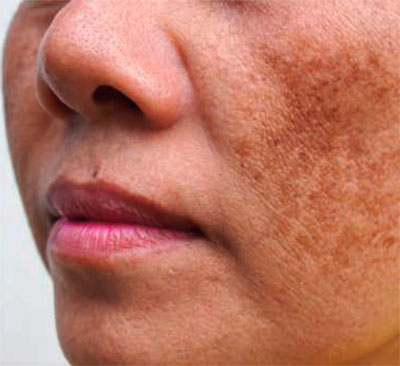Understanding Melasma in Cosmetic Practice: An In-depth Review
Hyperpigmentation disorders, such as melasma, present unique challenges and opportunities in cosmetic practice. Known as the “mask of pregnancy,” melasma is a common and complex skin condition that significantly impacts the individuals it affects. This article provides a comprehensive review of melasma, its implications in cosmetic practice, and approaches to management.

Melasma
What is Melasma?
Melasma is a skin condition characterized by the appearance of brown or gray-brown patches on the face. Although it can affect anyone, melasma is particularly common in pregnant women and those using hormonal contraceptives—hence the nickname, “mask of pregnancy.”
The hyperpigmentation typically occurs symmetrically, with matching marks on both sides of the face. The most common areas affected include the forehead, cheeks, upper lip, nose, and chin.

What Causes Melasma?
The exact cause of melasma remains unknown, but several factors appear to increase the risk. These include:
Hormonal Influences
Hormonal changes during pregnancy or from hormonal contraceptives can trigger melasma. These hormonal fluctuations may stimulate an overproduction of melanin, the pigment that gives skin its color.
Sun Exposure
UV radiation from the sun can exacerbate melasma. The rays can stimulate melanocytes—the cells that produce melanin—leading to further darkening of the patches.
The Role of the Cosmetologist in Managing Melasma
Cosmetologists can significantly contribute to the management and prevention of melasma in several ways:
Education on Sun Protection
Because sun exposure can exacerbate melasma, cosmetologists play a crucial role in educating clients about the importance of sun protection. This includes the use of broad-spectrum sunscreens with a high SPF, avoiding peak sun hours, and wearing protective clothing and hats when outside.
Skincare Recommendations
Cosmetologists can recommend effective skincare products that may help manage melasma. Topical creams containing active ingredients like hydroquinone, tretinoin, corticosteroids, or azelaic acid can help lighten the hyperpigmentation. Additionally, products with vitamin C, kojic acid, and licorice extract may also be beneficial.
Exfoliation Treatments
Certain exfoliation treatments, including microdermabrasion, chemical peels, and some laser therapies, can improve the appearance of melasma. These treatments work by removing the outermost layers of the skin, which may lessen the visibility of the dark patches.
Referral to Dermatologists
While cosmetologists can provide guidance and initial treatment for melasma, clients should also be referred to a dermatologist. Dermatologists can offer advanced treatment options and ensure the pigmentation changes are indeed melasma and not a symptom of another skin condition.
Conclusion
Melasma is a prevalent hyperpigmentation disorder that poses unique challenges to cosmetic professionals. However, with a deep understanding of this condition, cosmetologists can provide valuable insights, preventative measures, and effective treatment options for their clients dealing with melasma. Together with dermatologists, cosmetologists can help improve the skin health and self-confidence of their clients affected by this complex skin condition.






